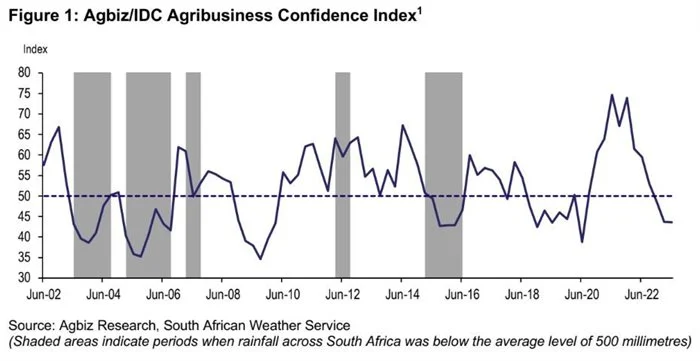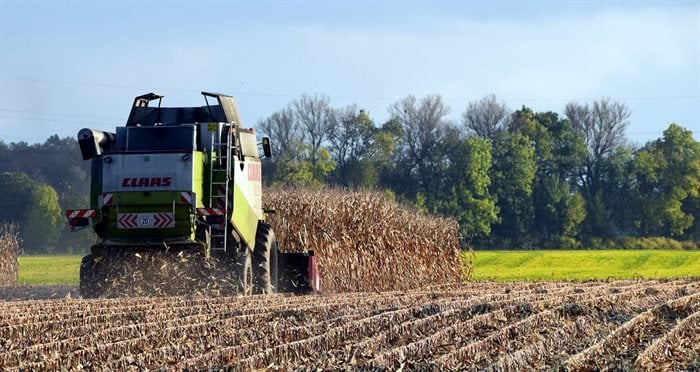After a 5-point decline to 44 in Q1 2023, the Agbiz/IDC Agribusiness Confidence Index (ACI) was unchanged in Q2.
The ACI level in the first two quarters of this year is the lowest since Q2 2020, when Covid-19 lockdown restrictions were first implemented. Notably, the second quarter reading marks the third consecutive quarter below the neutral 50-point level, implying that agribusinesses remain downbeat about business conditions.
Intensified geopolitical tensions, unfavourable draft water regulations, persistent episodes of load shedding, rising interest rates, poor road conditions and ongoing weaknesses in municipal service delivery were the key factors survey respondents cited as their prime concerns.
This survey was conducted in the first two weeks of June, covering businesses operating in all agricultural subsectors across South Africa.

Discussion of the sub-indices
The ACI comprises ten sub-indices, and six declined marginally in Q2 2023. This excludes the debtor provision for bad debt and financing costs sub-indices, which are interpreted differently from other sub-indices. Here is the detailed view of the subindices.
- The turnover sub-index fell 5 points from Q1 2023 to 64 points. Still, this current level is well above the long-term average, signalling that some farmers, specifically those in grains and oilseeds, will likely benefit from the ample 2022/23 season harvest.
- Similarly, the net operating income sub-index fell by 6 points to 61, reflecting that profitability will likely be squeezed amongst farming business enterprises as commodity prices have declined notably in recent months, and farmers had planted earlier in the season when input costs were reasonably high. This is true not only for grain farmers but across the various sub-sectors.
- The market share of the agribusiness sub-index dropped by just a point in Q2 2023 to 57. The respondents that mainly drove this notable decline are within the horticulture sub-sector, while other sub-sectors maintained a relatively unchanged view from the previous quarter.
- The capital investments sub-index fell 4 points from Q1 2023 to 55. Although this sub-index is still above the 50-mark point, the declining trend corroborates the weakening trend in tractor sales and other equipment we are starting to observe in the sector. Notably, the concerns about water rights regulations and weaknesses in municipality service delivery and road networks are critical risks to investment in farming businesses.
- The sub-index measuring the volume of exports sentiment declined by 3 points to 60 in Q2 2023. This illustrates the expected decline in export volumes this year from the robust levels of 2022, although the harvest is reasonably decent in all major crops and fruits.
- The general economic conditions sub-index is down a point from Q1 2023 to 10. This is the lowest level since the second quarter of 2020, when Covid-19 lockdowns were first implemented with various sectors closed, except for agriculture and the food value chain. The bleak assessment of general economic conditions speaks to the current challenging business conditions brought by persistent energy shortages, inefficiencies in the network industries, rising geopolitical tension, and higher interest rates, amongst other challenges.
- Unlike the rest of the sub-indices, the employment subindex remained flat from Q1 2023 at 48. Still, this is below the 50-point neutral mark and signals concern about employment conditions in the sector, especially as the general business conditions are constrained by a range of factors we outlined in the opening section. This is the case, although the employment data for the sector painted a robust picture for the first quarter, showing that 888,000 people were employed in primary agriculture, up 3% q/q and 5% y/y.
- The general agricultural conditions sub-index rose 17 points to 48 in Q2 2023. This optimism mirrors the favourable agricultural production conditions in the summer crop regions where South Africa expects decent harvests. For example, the 2022/23 maize harvest is estimated at 16,1 million tonnes, up 5% y/y and the third largest on record. The soybean harvest is estimated at a record 2,8 million tonnes. There is also expected harvest in other field crops such as sugar cane, horticulture, and livestock. Moreover, the outlook for winter crops is also positive following high rainfall in key producing provinces such as the Western Cape.
- The sub-indices of the debtor provision for bad debt and financing costs are interpreted differently from the abovementioned indices. A decline is viewed as a favourable development, while an uptick signals growing financial strain. In Q2 2023, the debtor provision for bad debt was down by 3 points to 33, which is favourable and signals better financial conditions on the back of a large summer crop. Meanwhile, the financing costs indices rose by 4 points to 7, showing the challenging environment of higher interest rates.
source: Agribusiness confidence remains subdued in Q2 (bizcommunity.com)



